Selecting the appropriate Stochastic Oscillator settings is essential for maximizing trading efficiency. Customizing %K and %D periods, tailoring them to market conditions, and utilizing additional indicators like moving averages and Fibonacci retracements can enhance signal accuracy. Implementing risk management strategies and experimenting with various settings further optimize trade outcomes. By fine-tuning parameters and continuously learning, traders can improve their performance and refine their strategies for better results. Understanding how to adjust these settings can lead to more informed trading decisions, helping traders navigate the markets with greater effectiveness. Enhance your trading potential by optimizing your Stochastic Oscillator settings.
Understanding Stochastic Oscillator Parameters
The comprehension of Stochastic Oscillator parameters is fundamental for adeptly interpreting market dynamics and optimizing trading strategies. The Stochastic Oscillator consists of two lines, %K and %D, which serve as key indicators in technical analysis.
%K measures the most recent closing price relative to the high-low range over a specified period, while %D is a simple moving average of %K. By adjusting the settings of the Stochastic Oscillator, traders can tailor the indicator to their specific trading styles. The customization of the time periods impacts the sensitivity and responsiveness of the Oscillator, influencing its ability to identify potential buy or sell signals.
Understanding the concepts of oversold and overbought conditions in relation to the Stochastic Oscillator can further enhance its effectiveness in recognizing market trends. Mastery of these parameters is essential for traders seeking to optimize their trading decisions and capitalize on profitable opportunities in the market.
Customizing %K and %D Periods

To enhance the effectiveness of the Stochastic Oscillator, customization of %K and %D periods plays a crucial role in tailoring trading signals to individual preferences and market conditions. Experimenting with different %K and %D period combinations is essential to finding the best settings for specific trading styles and preferences.
Shorter %K periods result in a more volatile oscillator, providing early signals but potentially more false signals. Longer %K periods offer smoother oscillator movements, delivering delayed yet more reliable signals. Matching %K and %D periods can improve signal accuracy and reduce noise in trending markets. Adjusting %K and %D periods impacts the sensitivity and smoothness of the Stochastic Oscillator. Customizing %K and %D periods allows traders to adapt the oscillator to their specific preferences and market conditions effectively.
Fine-Tuning for Market Conditions
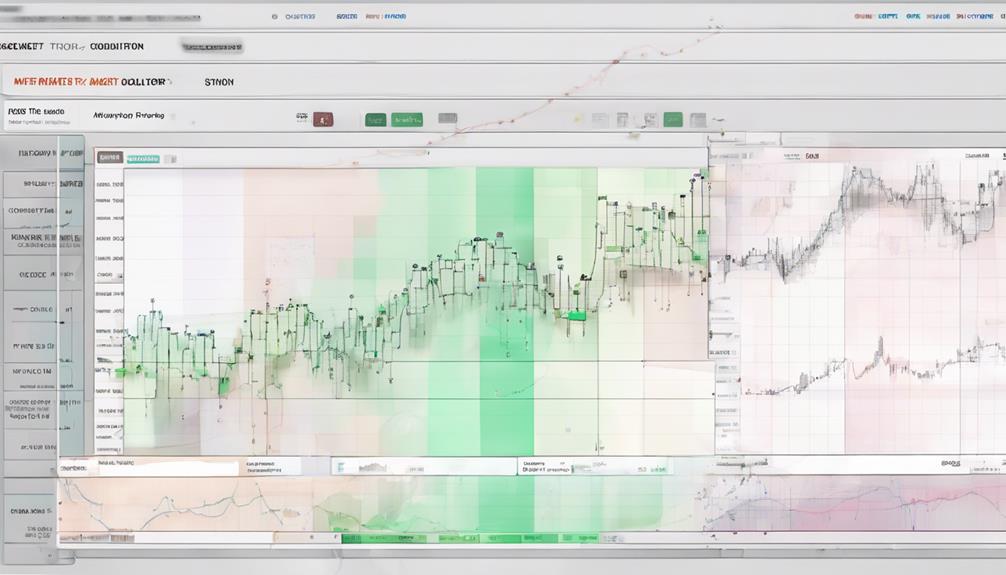
Customizing Stochastic Oscillator settings to fine-tune for varying market conditions and trading styles is essential in optimizing trading efficiency and accuracy. By adjusting parameters like Fast %K period, Slow %K period, and Slow %D period, traders can adapt to different levels of volatility and price ranges.
This customization enhances the effectiveness of the momentum indicator, allowing for more precise identification of oversold levels and potential trend reversals when Stochastic lines cross. Experimenting with various Stochastic settings and conducting thorough backtesting can provide valuable insights into which configurations work best under specific market conditions.
Finding the most suitable Stochastic settings for different instruments and timeframes is vital for improving overall trading performance. Traders need to take into account the unique characteristics of each market environment and tailor their Stochastic Oscillator settings accordingly to achieve maximum efficiency and accuracy in their trades.
Enhancing Signal Accuracy With Indicators
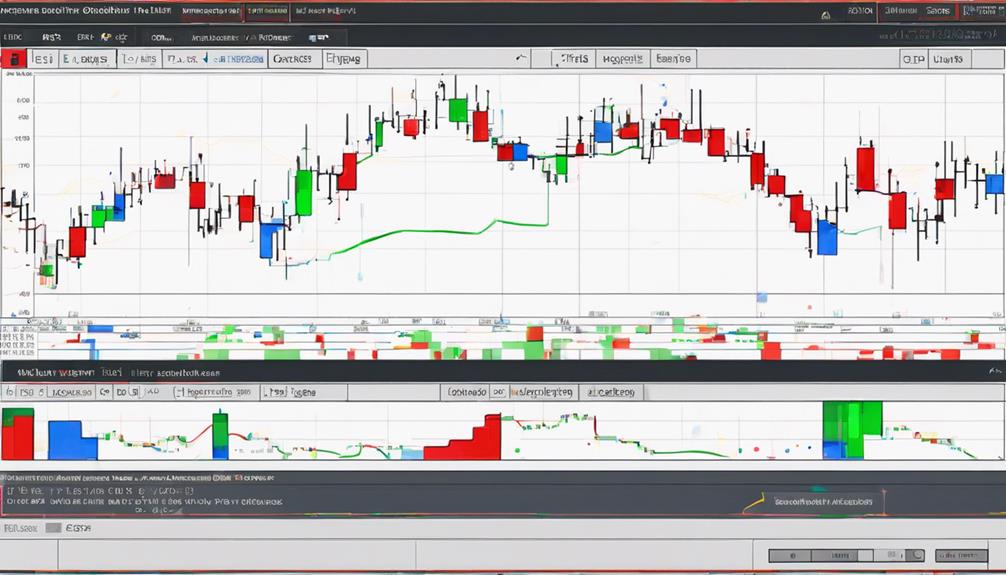
Enhancing signal accuracy with supplementary indicators can greatly bolster the effectiveness of Stochastic Oscillator analysis. When combined strategically, these indicators can refine trade signals and provide a more thorough view of market dynamics.
Consider the following techniques to enhance signal accuracy:
- Utilizing moving averages alongside Stochastic Oscillator can offer additional confirmation of trend direction.
- Incorporating Fibonacci retracement levels with Stochastic Oscillator signals can optimize entry and exit points.
- Pairing Stochastic Oscillator with support and resistance levels can increase the reliability of trade signals.
- Validating the strength of price movements by integrating volume analysis with Stochastic Oscillator readings.
- Identifying significant trend changes by applying trendline analysis to Stochastic Oscillator crossovers.
Improving Risk Management Strategies
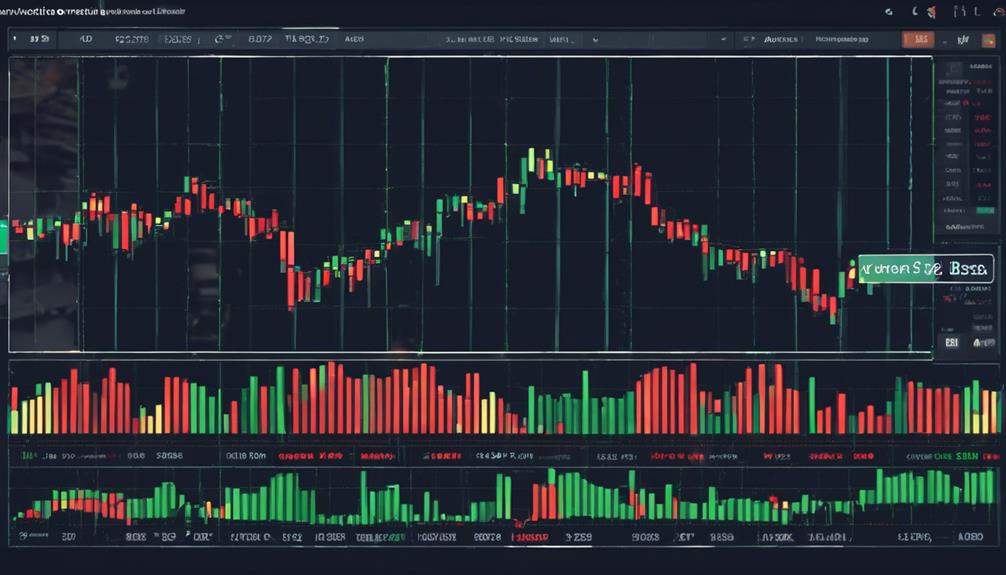
Effective risk management strategies are essential in trading with the Stochastic Oscillator to safeguard capital and optimize trading outcomes.
By utilizing risk allocation techniques and precise position sizing methods, traders can control potential losses and enhance profitability.
Implementing stop-loss orders, time stops, and calculating risk-reward ratios are vital components in developing a robust risk management framework.
Risk Allocation Techniques
Applying sound risk allocation techniques is fundamental in bolstering overall risk management strategies for traders seeking to safeguard capital and optimize trade outcomes. When it comes to improving risk management, several key techniques can be employed:
- Utilizing the 1% rule to limit the risk exposure on individual trades effectively.
- Implementing stop-loss orders and position sizing to protect capital and minimize losses.
- Diversifying trades across various assets or markets to reduce overall risk exposure.
- Regularly adjusting risk allocation strategies based on market conditions to adapt to changing dynamics.
- Monitoring individual trading performance to assess the effectiveness of risk management techniques and make necessary adjustments for long-term success.
Position Sizing Methods
Implementing appropriate position sizing methods is essential for enhancing risk management strategies and optimizing trade outcomes in volatile markets. Position sizing techniques such as fixed dollar amount, percentage of account balance, percentage of trading capital, and the Kelly Criterion formula play a significant role in determining the amount of capital to risk on each trade based on factors like risk tolerance and account size.
Adapting to Different Trading Styles

Tailoring Stochastic Oscillator settings to suit different trading styles is essential for optimizing trading strategies and achieving desired outcomes in the financial markets. Adapting to different trading styles involves customizing Stochastic settings to align with specific strategies, risk tolerance levels, and objectives.
Here are five key points for adjusting Stochastic settings to different trading styles:
- Short-term traders may benefit from lower Stochastic settings for quicker signals.
- Long-term traders often prefer higher Stochastic settings to capture major price movements.
- Scalpers might find shorter lookback periods and less smoothing useful for rapid responses to price changes.
- Swing traders may opt for longer-term Stochastic settings to align with their trading style.
- Tailoring Stochastic Oscillator settings to match individual trading preferences and risk tolerance levels can lead to more accurate identification of overbought and oversold conditions, better determination of entry and exit points, and ultimately, more profitable trades.
Disciplined Optimization Techniques
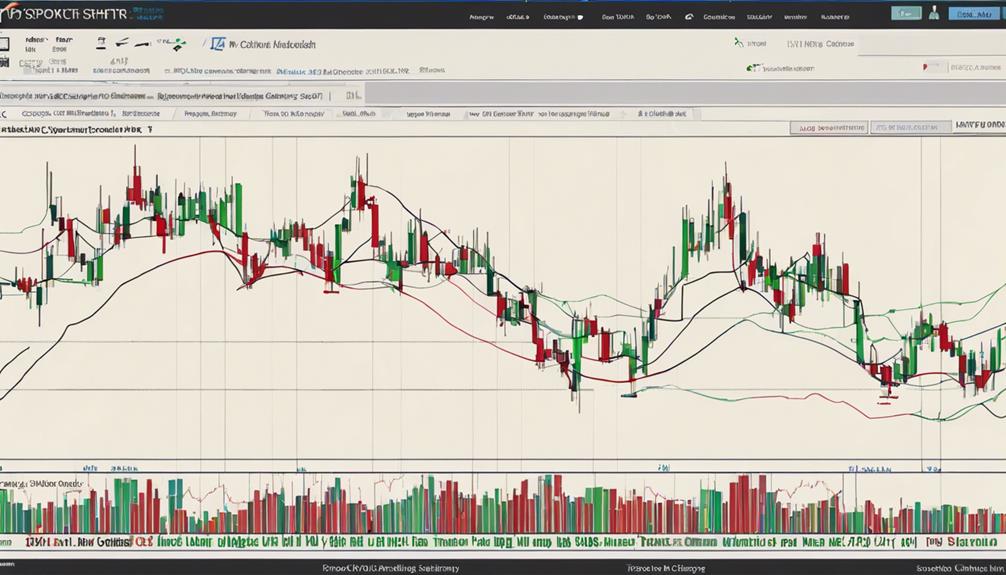
When optimizing stochastic oscillator settings, it is essential to employ data-driven strategies to enhance trading efficiency. Consistent adjustments to parameters based on thorough analysis can lead to improved signal accuracy and performance.
Monitoring key performance metrics allows traders to gauge the effectiveness of their optimization techniques and make informed decisions for better trading outcomes.
Data-Driven Optimization Strategies
Through the meticulous analysis of historical data and disciplined statistical techniques, traders can strategically optimize Stochastic Oscillator settings to enhance trade performance. By utilizing data-driven insights and disciplined optimization methods, traders can fine-tune their Stochastic Oscillator parameters for maximum efficiency in various market conditions. Here are five key strategies for data-driven optimization:
- Utilize historical data analysis to identify ideal Stochastic Oscillator settings for specific trading strategies.
- Backtest various parameter combinations to determine the most effective settings in different market conditions.
- Implement disciplined optimization techniques based on statistical analysis to enhance trade accuracy.
- Consider factors like market volatility, trend strength, and asset class characteristics when optimizing Stochastic Oscillator settings.
- Use data-driven insights to fine-tune Stochastic Oscillator parameters for maximum efficiency in trade execution.
Consistent Parameter Adjustments
In the domain of optimizing trades with Stochastic Oscillator settings, consistent parameter adjustments play a pivotal role in adapting to various trading styles and market conditions. Fine-tuning parameters such as Fast %K period, Slow %K period, and Slow %D period is essential for disciplined optimization techniques. By tailoring these settings to individual preferences and risk tolerance, traders can enhance their performance and accuracy in identifying entry and exit points.
Regular review and adjustment of Stochastic Oscillator settings are vital to maintain efficiency and effectively navigate changing market dynamics. These optimization techniques are data-driven and analytical, ensuring that the Stochastic Oscillator provides reliable signals tailored to specific trading styles and current market conditions.
Monitoring Performance Metrics
To effectively optimize trades with Stochastic Oscillator settings, closely monitoring performance metrics serves as a cornerstone of disciplined optimization techniques.
- Evaluate key performance metrics such as win rate, risk-reward ratio, and maximum drawdown to assess the effectiveness of different Stochastic Oscillator settings.
- Systematically adjust parameters like period lengths and smoothing factors using disciplined optimization techniques to enhance trading performance.
- Utilize historical data analysis to compare results from various settings and pinpoint the best configuration for maximum efficiency.
- Fine-tune strategies by monitoring trade outcomes with different Stochastic Oscillator settings to guarantee consistent profitability.
- Implement a structured approach to testing and optimizing Stochastic Oscillator settings to refine trading decisions and boost overall trading results.
Experimenting With Diverse Settings
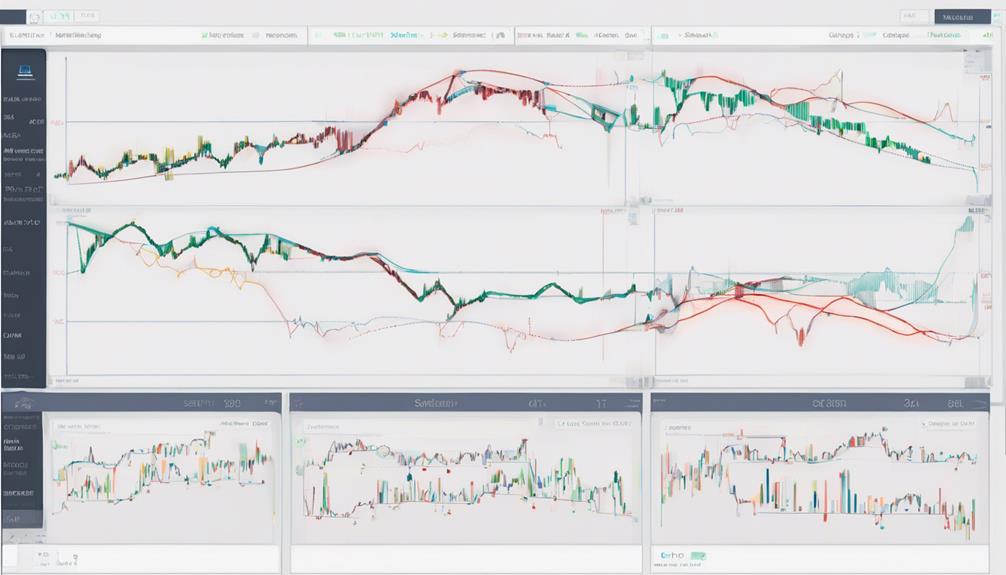
Exploring a variety of diverse settings for the Stochastic Oscillator can greatly impact its effectiveness in capturing price movements and enhancing trade decisions. Experimenting with different Fast %K periods, such as 5, 8, or 14, allows traders to adjust the sensitivity of the oscillator to price changes.
Similarly, modifying Slow %K periods, like 3, 5, or 8, can enhance trend identification by smoothing out signals. Altering Slow %D periods, such as 3, 5, or 8, influences the lagging nature of the signals in response to price fluctuations.
Customizing overbought and oversold levels, typically set at 80 and 20, refines the accuracy of signals for trade entries and exits. By testing various combinations of Fast %K, Slow %K, and Slow %D periods, traders can optimize the Stochastic Oscillator to align with their specific trading style and preferences.
This experimentation with diverse settings is essential in tailoring the oscillator to individual trading strategies, ultimately maximizing its utility in decision-making processes.
Maximizing Efficiency in Trading
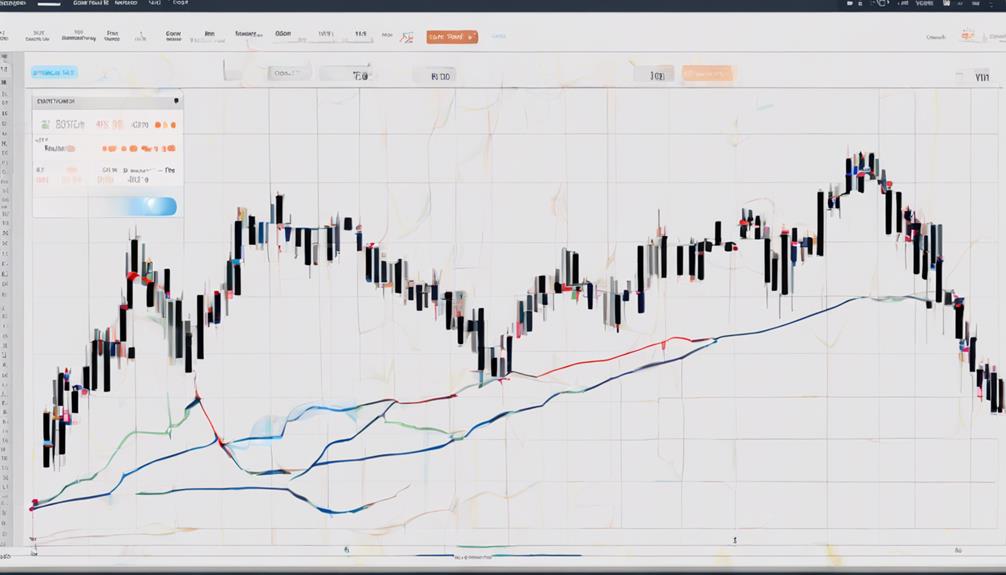
Efficient trading strategies can be maximized through meticulous customization of Stochastic Oscillator settings, optimizing its responsiveness to short-term price movements. When aiming to maximize efficiency in trading, traders should consider the following key factors:
- Optimal Settings: Finding the perfect balance between Fast %K period, Slow %K period, and Slow %D period is essential for achieving ideal results.
- Customization: Tailoring the Stochastic Oscillator settings to suit individual trading styles can greatly enhance accuracy in capturing short-term price movements.
- Backtesting: Experimenting with different settings and backtesting strategies is crucial to identify the most effective Stochastic Oscillator configuration.
- Signal Reliability: Adapting the settings to match the fast-paced nature of trading can improve signal reliability, leading to more informed trading decisions.
- Minimize False Signals: Proper adjustment of Stochastic Oscillator settings is necessary to reduce false signals, ensuring trading strategies are executed with precision and effectiveness.
Tailoring Oscillator for Success
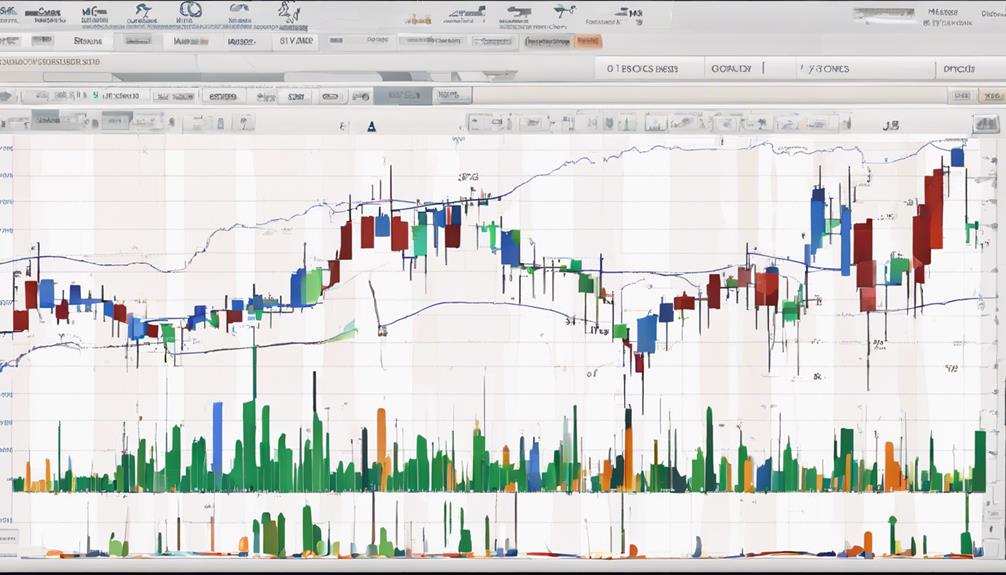
Tailoring the oscillator settings to align with specific trading objectives is a pivotal strategy in optimizing trading success through enhanced precision and efficiency. Customizing the Fast %K period to 5 and Slow %K period to 3 can improve short-term trade accuracy by capturing momentum effectively.
Additionally, adjusting the Slow %D period to 3 helps in generating smoother signals for efficient decision-making, especially when identifying overbought and oversold conditions.
Experimenting with different stochastic settings is vital in finding the most suitable parameters that suit individual trading styles, enabling traders to receive timely buy signals and sell signals.
Backtesting various configurations plays a significant role in determining the most effective settings that lead to maximum trading efficiency and profitability. Finding the right stochastic settings is essential for traders looking to make informed decisions and capitalize on market opportunities while mitigating risks.
Continuous Learning for Better Outcomes

Continuous learning plays an essential role in enhancing trade outcomes by providing traders with the knowledge and insights needed to make informed decisions.
By staying informed about market dynamics, economic events, and trading strategies, traders can adapt their Stochastic Oscillator settings effectively.
Engaging in educational activities and continuously refining one's trading approach through learning can lead to improved results and sustained success in the market.
Learning Boosts Trade Results
Enhancing trade outcomes through continuous learning remains a cornerstone for achieving better results in the dynamic landscape of financial markets.
Staying updated on market trends, strategies, and tools is essential.
Regularly practicing new techniques can lead to improved trade outcomes.
Engaging in educational resources, webinars, and forums provides valuable insights.
Experimenting with different settings and strategies enhances trading efficiency.
Adapting to changing market conditions through learning helps traders stay competitive.
Improvement Through Education
In the pursuit of peak trade performance, ongoing education serves as a vital pillar for refining skills and achieving superior decision-making capabilities in the ever-evolving financial markets. Continuous learning about technical indicators like the Stochastic Oscillator and understanding market dynamics can greatly enhance trade execution. By staying informed and updated on the latest trends and insights, traders can optimize their trading strategies for better outcomes. Educating oneself on the nuances of Stochastic Oscillator settings is essential for maximizing trading efficiency. Learning from reputable sources and regularly updating knowledge on technical analysis tools are key steps towards improving trade results.
| Benefits of Education | Impact on Trading |
|---|---|
| Enhanced Decision-making Skills | Improved Trade Execution |
| Better Understanding of Market Dynamics | Optimized Trading Strategies |
| Mastery of Technical Indicators | Enhanced Trading Efficiency |
| Continuous Learning | Superior Trade Outcomes |
Frequently Asked Questions
What Is the Best Stochastic Oscillator Setting for Day Trading?
In day trading, determining the best stochastic oscillator setting involves a nuanced approach. This takes into account short-term strategies, entry and exit signals, risk management, volatility analysis, trend identification, and indicator customization.
By experimenting with various configurations and rigorously backtesting results, traders can optimize their stochastic oscillator settings. This optimization enhances decision-making and improves trading outcomes in dynamic market conditions.
This process guarantees that the selected parameters align with the specific requirements of a day trading strategy.
What Is Stochastic 14-3-3?
Stochastic 14-3-3 is a specific configuration of the Stochastic Oscillator, defining the calculation parameters as a 14-period %K, a 3-period SMA of %K for %D, and a smoothing factor of 3.
This setting enhances the indicator's sensitivity to short to medium-term price movements, offering traders quicker responses to market shifts and potential trend reversals.
It balances responsiveness with reliability, making it valuable for identifying overbought/oversold conditions and capturing short-term trading opportunities.
What Is 5-3-3 Stochastic Settings?
The 5-3-3 Stochastic settings pertain to a configuration for stochastic oscillators, a key tool in technical analysis. These settings are instrumental in various trading strategies by offering insights into momentum, price action, and market volatility.
With a focus on risk management and trend identification, the 5-3-3 settings excel in capturing quick price movements and identifying potential overbought or oversold market conditions. Traders often utilize these settings for intraday and short-term trading approaches.
What Is the Best Time Frame to Trade Stochastic Oscillator?
The best time frame to trade Stochastic Oscillator varies based on trading strategies and goals. Scalping strategies often utilize shorter time frames like 5-minute charts for quick trades.
Swing trading techniques benefit from 1-hour or 4-hour charts for capturing medium-term trends. Intraday signals are commonly found on the 15-minute chart, while long-term analysis is suited for daily or weekly time frames.
Traders should consider price action, trend identification, risk management, and entry/exit points when selecting a time frame.
Conclusion
To sum up, fine-tuning stochastic oscillator settings is vital for maximizing trading efficiency. By comprehending parameters, customizing %K and %D periods, and adjusting for market conditions, traders can enhance signal accuracy and improve risk management strategies.
Continuous learning and experimentation with diverse settings can lead to tailored success in trading. For instance, a trader who adapted their stochastic oscillator settings based on market volatility saw a significant increase in profitability and reduced losses over time.


